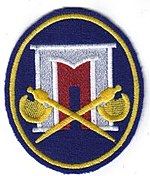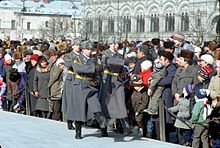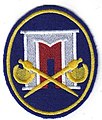Kremlin Regiment
This article includes a list of general references, but it lacks sufficient corresponding inline citations. (May 2012) |
| Presidential Regiment | |
|---|---|
 Ensign of the Kremlin Regiment | |
| Active | 1936[1] - present |
| Country | |
| Branch | Federal Protective Service |
| Role | Honour Guard escorts |
| Motto(s) | Верность, Честь, Долг (Russian) Fidelity, Honour, Duty |
| Engagements | Великая Отечественная война (Russian) The Great Patriotic War |

The Kremlin Regiment (Russian: Кремлëвский полк [Kremlyovskiy polk]), also called the Presidential Regiment, (Президентский полк [Prezidentskiy polk]) is a unique military regiment and part of the Russian Federal Protective Service with the status of a special unit. The regiment ensures the security of the Kremlin, its treasures, and state officials. In accordance with the federal law of December 8, 1997 "On Immortalizing the Soviet People’s Victory in the Great Patriotic War of 1941–1945", the regiment also maintains a guard of honor (Russian: Почётный караул) at the eternal flame of the Tomb of the Unknown Soldier. The regiment is housed in the historic Kremlin Arsenal.
History


When the leaders of the Soviet Union moved from Petrograd to the Moscow Kremlin in early 1918, their protection was entrusted to the Red Latvian Riflemen, under the command of the Commandant of the Kremlin Garrison. In September 1918, the Latvian Riflemen left for the fronts of the Civil War, and they were replaced by the officer cadets of the 1st WPKA Soviet Joint Military School "All-Russian Central Executive Committee" that were redeployed into the Kremlin for this purpose. In 1924, they were assigned with the duty to guard Lenin's Mausoleum by orders of the ARCEC.
In October 1935, the officers' academy left the Kremlin for the Moscow district of Lefortovo and a Special Purpose Battalion was created to replace them on Kremlin and Mausoleum guard duties. On January 28, 1936, the battalion – and the Kremlin Garrison (Komendatura Kremlya), to which it was subordinated – were transferred from the People's Commissariat of Defense of the USSR to the People's Commissariat of Internal Affairs (NKVD) of the USSR. The UKMK and the 1st Division were separate public security units with neither subordinate to the other, which would not prevent them collaborating closely in Kremlin security activities.
On April 8, 1936, in accordance with Order No. 122 for the Moscow Kremlin Garrison, the Special Purpose Battalion became the Special Purpose Regiment; this day is considered the birthday of the regiment. However, the Regiment's Day is celebrated annually on May 7.
When the Great Patriotic War began in 1941, the units of the Kremlin Garrison were made responsible for defending the Kremlin, where the State Defense Committee and Chief Military Headquarters were located. On June 25, 1941, the Commandant of the Garrison ordered the regiment to reinforce the defenses, and the regiment set up round-the-clock guard on the Kremlin walls. In 1942–1943 four groups of snipers from the Kremlin Regiment were sent to the Western and Volkhov Fronts. The snipers killed more than 1,200 German soldiers and officers, losing only 97 men in combat.[2] On February 23, 1944 the Kremlin Regiment was decorated with the Order of the Red Banner. Three battalions from the regiment took part in the Moscow Victory Parade of 1945 on Red Square.
In 1952 the regiment was reorganized into the Separate Special Purpose Regiment. On May 7, 1965 it was decorated with the Order of the Red Banner for its military achievements during the Great Patriotic War. On May 8, 1967 the regiment took part in the unveiling ceremony of the Tomb of the Unknown Soldier in the Alexander Garden. In 1973 the unit was renamed the Separate Red Banner Kremlin Regiment, later receiving an Order of the October Revolution. Before being deprived of Mausoleum guard duties in 1993 as a result of the collapse of the Soviet Union and the constitutional crisis of that year, the regiment finally received its current designation in accordance with a presidential decree of March 20 that year, this time under the Federal Protective Service. Since 1997 the Kremlin Regiment has resumed guard duties by presidential decree on the Tomb of the Unknown Soldier and its Eternal Flame, keeping alive the legacy of those who served on the Eastern Front.

On September 2, 2002 on the basis of the 11th Cavalry Regiment (the Moscow Military District movie-making cavalry unit) a cavalry escort unit was formed as part of the Presidential Regiment. Starting in 2004 a Guard Mounting ceremony has been held on Cathedral Square on Sundays, from March to October.
On May 7, 2006 the regiment gained a new regimental color, modeled on the ones used by the Imperial Guard units. It has also recently acquired special ceremonial uniforms closely modeled on those worn on parade by the infantry and the cavalry of the Russian Imperial Guard until 1914. These are worn in addition to modern style dress uniforms adopted during the final years of the Soviet period. Both types of uniform are in dark green with medium blue piping, but the shoulder boards in the historical full dress is different, even through the ranks are just the same, while only officers wear epaulettes in the latter. When in modern dress uniforms, they wear blue berets or peaked caps, but wear the shako, gorgets and tall period boots with the historical full dress, carrying the SKS rifle or sabres in both cases. This is also the case of the Regiment's Presidential Band, which wears white uniforms similar to those by the Imperial Guard bands of the late 19th century.
Since 2005 the Cavalry Escort Squadron wears, on select occasions, uniforms worn by the cavalry units of the Red Army and the NKVD. Uniforms based on the ones used by the Regiment during the Second World War were worn for the first time by a platoon from the 1st Honor Guard Company during the 2015 Spasskaya Tower International Military Music Festival.
On April 16, 2016, the Guard Mounting that day featured the first woman officer to serve in the Cavalry Squadron, the first time this had happened in a guard changing ceremony.[3] This was also the first to be live streamed online.[4]
Notable servicemen of Kremlin Regiment
- Mikhail Kasyanov, former Prime Minister of Russia [5]
- Alexander Korzhakov, former head of the Federal Protective Service of Russia [6]
- Andrei Lugovoi, deputy of the State Duma [7] who was later indicted by UK authorities on charges of murdering Alexander Litvinenko.
Component units
- Regiment HQ
- Presidential Band of the Kremlin Regiment
- 1st Battalion, Kremlin Regiment
- 2nd Company
- 3rd Company
- 4th Company
- 5th Company
- 2nd Battalion, Kremlin Regiment
- 6th Company
- 7th Company
- 8th Company
- 9th Company
- 3rd Battalion, Kremlin Regiment
- 1st Honor Guard Company
- 11th Honor Guard Company
- Automotive Company
- Presidential Cavalry Escort Battalion, Kremlin Regiment (former 11th Cavalry Regiment)
- 10th Company
- 12th Company
- 1st Cavalry Squadron
- 2nd Cavalry Squadron
- Support Squadron
- 4th Operational Reserve Battalion, Kremlin Regiment
- Operational Reserve Company
- Protection Company
Gallery
-
Kremlin Regiment patch
-
Full dress uniform
-
Vladimir Putin inauguration 7 May 2012
-
Guarding the Tomb of the Unknown Soldier, with a ceremonial SKS rifle
-
Honour guard in Alexander Garden
See also
- Federal Protective Service of Russia
- Awards of the Federal Protective Service of the Russian Federation
- Federal Security Service of Russia
- Ninth Chief Directorate
- 154th Preobrazhensky Independent Commandant's Regiment
Notes
- ^ Russia: Putin celebrates Kremlin Regiment's 80th anniversary
- ^ The Presidential Regiment Archived 2006-06-15 at the Wayback Machine
- ^ https://www.youtube.com/watch?v=yYfPIV3wsEU
- ^ https://www.youtube.com/watch?v=4rCehtzkjjw
- ^ http://www.gazeta.ru/kasyanov.shtml
- ^ "Archived copy". Archived from the original on 2006-01-05. Retrieved 2006-01-05.
{{cite web}}: Unknown parameter|deadurl=ignored (|url-status=suggested) (help)CS1 maint: archived copy as title (link) - ^ http://www.grani.ru/Events/Crime/m.127492.html





